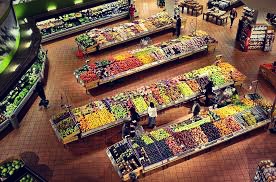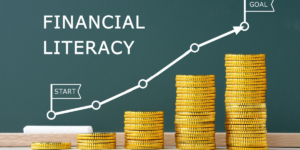
For example, take the way that the entryway doors operate at most supermarkets. Supermarkets install one-way doors at the entrance to keep you in there once you enter. Instead of being able to turn around and walk back out, you have to walk parts of the store to get to the exit. The hope is that you will be compelled to buy something before you make your way to the exit.
7 Ways Supermarkets Trick You into Spending More Than You Should
Once you are in the store, the supermarket uses a variety of different tricks to get you to buy and spend more. They research everything from the lighting and music to the floor plan, the layout of the aisles, and the exact presentation that is most likely to get shoppers to spend more money.
While poor spending habits might account for some of your overspending, much of it comes down to the subtle tricks that supermarkets use to get more money out of every customer. If you are looking to manage your grocery budget a little better, being aware of these grocery store tips is one way to prevent yourself from falling victim to them.
Here are the 7 ways supermarkets trick you into spending.
-
At the Entrance
The supermarket tries to influence your senses from the moment you walk in the door. The common layout is to have shoppers enter right into the produce section. The look and the smell of fresh produce is intended to create positive associations. You may have also noticed that many stores have a floral department right near the entrance. The vibrant colors of the flowers are there to give the scenery more life and to make the supermarket seem more inviting.
Another tactic is to position high margin items near the entrance. When you first walk in the store with an empty cart, you feel good and are ready to spend. Customers are much more likely to pick these items up if they are near the front. Later on in your journey, you already have it in mind that you have spent enough money, and you would be less likely to purchase an unnecessary item that costs more. Understanding the grocery store map will also help you avoid pitfalls that may cause you to overspend.
-
Essentials in the Back
Items like eggs and milk are almost always found at the back of the supermarket. The reason is that these items are considered essentials. Almost every shopper has at least one item from the dairy section on his or her list. If those items were near the front, you might just pick them up and head to the register without spending much time in the store. By placing them far from the entrance, they can force shoppers to walk through more of the store. On the way to pick up the essential items that are on your list, you’ll be tempted by a variety of other products that you would not have even thought about buying if you didn’t see them first. To avoid impacting your progress towards debt relief, try making a list to help avoid impulse buys.
-
In the Aisles
The supermarket puts the items they want you to buy at eye level. They want the most profitable items to be the ones that you see first. These eye level items usually cost more and offer a higher profit for the supermarket. You will find the lower cost items offering a better value towards the top and bottom shelves.
Supermarkets even employ this trick when it comes to the items that your child may want. The cereal aisle provides a good example. The adult cereals are placed at eye level with adult consumers, and for children’s cereal, the manipulation goes one step further. Cereals that are marketed toward children are positioned to increase the chance of incidental eye contact between the child and the character on the box. Studies have shown that this is a common tactic, and that it does affect the preference of the child.
-
The Floor Plan
Supermarkets are also designed to get shoppers to follow a more favorable path as they walk through the store. You may have noticed that most shoppers tend to follow a counter clockwise path as they work their way through the supermarket. To some degree, this is just preference, but the stores also design the floor plan to encourage people to follow this path.
The reason is that people tend to spend a little bit more when they go through the grocery store in a counter-clockwise direction. Supermarkets have studied this by putting tracking devices in the carts and matching the spending to the direction followed by the consumer. It only averages out to a few dollars per shopper, but this few dollars adds up when you have millions of shoppers entering the store every year.
-
Impulse Buys
Most people do not go to the supermarket intending to buy a single candy bar or a pack of gum. That is why these items are placed at the register. It is the one place that every customer must go, and they know that people are very likely to pick these items up and place them in their cart while they are waiting to pay.
This trick works on two levels. The first is that it is a way to tempt people that would not have gone looking for candy in the store. The second is that the register is your last chance to pick up any items. If you are looking at a candy bar and thinking about buying it, the fact that you are on the way out the door may induce you to select one more convenient item before you head out. Bringing a list to avoid any impulse buys is always important, but especially so if you are working on getting rid of debt.
-
Making Partners
As a supermarket shopper, you will also find certain items paired up on the shelves. That is because the supermarket knows that people are more likely to buy one of the items when they buy the other. This is why you will find peanut butter and jelly shelved together. You may also notice that they put salsa right near tortilla chips. Even if you are buying one of these items for another reason, they know that you will be more likely to buy its common pair if it’s near it.
-
The End Caps
The displays at the ends of the aisles are there to sell you products that you would not have considered. The nice display at the end of the aisle signals that these are products to pay attention to. They also highlight the price of the product to make you think that there is something special about the price, when in many cases, is the same price that it is at any other time. Companies pay large fees to get their products featured on the end caps, and it helps them to sell more.
With many of these tricks, there is not much that a consumer can do to avoid them. The key is to know they exist and to be aware of the tactics that are used against you when you enter the supermarket. Beyond that, the best piece of advice for a person trying to manage a grocery budget is to make a shopping list and stick to it. By making your purchasing decisions before you enter the store, you can reduce the influence that the supermarket will have on your shopping behavior and put that money towards managing debt.
Author Bio: Jennifer Jones loves finding ways to live frugally that ENHANCE life instead of making you feel like you are missing out on the things you want to do. You can read more of her writing at The Frugal Mrs. Jones.
If you’re struggling to pay off debt, ACCC can help. Schedule a free credit counseling session with us today.






